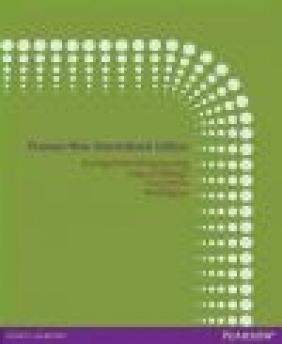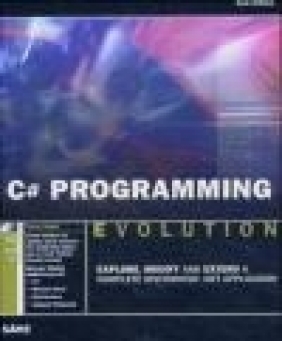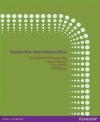Starting out with Programming Logic and Design
Tony Gaddis
Starting out with Programming Logic and Design
Tony Gaddis
- Producent: Pearson
- Rok produkcji: 2013
- ISBN: 9781292042251
- Ilość stron: 442
Niedostępna
Opis: Starting out with Programming Logic and Design - Tony Gaddis
Starting Out with Programming Logic and Design, Third Edition, is a language-independent introductory programming book that orients students to programming concepts and logic without assuming any previous programming experience. In the successful, accessible style of Tony Gaddis' best-selling texts, useful examples and detail-oriented explanations allow students to become comfortable with fundamental concepts and logical thought processes used in programming without the complication of language syntax. Students gain confidence in their program design skills to transition into more comprehensive programming courses. The book is ideal for a programming logic course taught as a precursor to a language-specific introductory programming course, or for the first part of an introductory programming course.Preface xiii Chapter 1 Introduction to Computers and Programming 1 1.1 Introduction ... 1 1.2 Hardware ... 2 1.3 How Computers Store Data ... 7 1.4 How a Program Works ... 12 1.5 Types of Software ... 20 Review Questions ... 23 Chapter 2 Input, Processing, and Output 29 2.1 Designing a Program ... 29 2.2 Output, Input, and Variables ... 34 2.3 Variable Assignment and Calculations ... 43 IN THE SPOTLIGHT: Calculating a Percentage ... 47 IN THE SPOTLIGHT: Calculating an Average ... 50 IN THE SPOTLIGHT: Converting a Math Formula to a Programming Statement ... 53 2.4 Variable Declarations and Data Types ... 56 2.5 Named Constants ... 62 2.6 Hand Tracing a Program ... 63 2.7 Documenting a Program ... 64 IN THE SPOTLIGHT: Using Named Constants, Style Conventions, and Comments ... 66 Review Questions ... 68 Programming Exercises ... 72 Chapter 3 Modules 75 3.1 Introduction to Modules ... 75 3.2 Defining and Calling a Module ... 78 IN THE SPOTLIGHT: Defining and Calling Modules ... 84 3.3 Local Variables ... 88 3.4 Passing Arguments to Modules ... 90 IN THE SPOTLIGHT: Passing an Argument to a Module ... 95 IN THE SPOTLIGHT: Passing an Argument by Reference ... 100 3.5 Global Variables and Global Constants ... 104 IN THE SPOTLIGHT: Using Global Constants ... 105 Review Questions ... 109 Programming Exercises ... 113 Chapter 4 Decision Structures and Boolean Logic 115 4.1 Introduction to Decision Structures ... 115 IN THE SPOTLIGHT: Using the If-Then Statement ... 122 4.2 Dual Alternative Decision Structures ... 125 IN THE SPOTLIGHT: Using the If-Then-Else Statement ... 126 4.3 Comparing Strings ... 131 4.4 Nested Decision Structures ... 135 IN THE SPOTLIGHT: Multiple Nested Decision Structures ... 138 4.5 The Case Structure ... 142 IN THE SPOTLIGHT: Using a Case Structure ... 145 4.6 Logical Operators ... 147 4.7 Boolean Variables ... 154 Review Questions ... 155 Programming Exercises ... 159 Chapter 5 Repetition Structures 163 5.1 Introduction to Repetition Structures ... 163 5.2 Condition-Controlled Loops: While, Do-While, and Do-Until ... 164 IN THE SPOTLIGHT: Designing a While Loop ... 169 IN THE SPOTLIGHT: Designing a Do-While Loop ... 178 5.3 Count-Controlled Loops and the For Statement ... 183 IN THE SPOTLIGHT: Designing a Count-Controlled Loop with the For Statement ... 191 5.4 Calculating a Running Total ... 201 5.5 Sentinels ... 205 IN THE SPOTLIGHT: Using a Sentinel ... 206 5.6 Nested Loops ... 209 Review Questions ... 211 Programming Exercises ... 214 Chapter 6 Functions 217 6.1 Introduction to Functions: Generating Random Numbers ... 217 IN THE SPOTLIGHT: Using Random Numbers ... 221 IN THE SPOTLIGHT: Using Random Numbers to Represent Other Values ... 223 6.2 Writing Your Own Functions ... 225 IN THE SPOTLIGHT: Modularizing with Functions ... 232 6.3 More Library Functions ... 240 Review Questions ... 251 Programming Exercises ... 253 Chapter 7 Input Validation 257 7.1 Garbage In, Garbage Out ... 257 7.2 The Input Validation Loop ... 258 IN THE SPOTLIGHT: Designing an Input Validation Loop ... 260 7.3 Defensive Programming ... 265 Review Questions ... 266 Programming Exercises ... 268 Chapter 8 Arrays 269 8.1 Array Basics ... 269 IN THE SPOTLIGHT: Using Array Elements in a Math Expression ... 276 8.2 Sequentially Searching an Array ... 283 8.3 Processing the Contents of an Array ... 289 IN THE SPOTLIGHT: Processing an Array ... 296 8.4 Parallel Arrays ... 303 IN THE SPOTLIGHT: Using Parallel Arrays ... 304 8.5 Two-Dimensional Arrays ... 307 IN THE SPOTLIGHT: Using a Two-Dimensional Array ... 311 8.6 Arrays of Three or More Dimensions ... 316 Review Questions ... 317 Programming Exercises ... 320 Chapter 9 Sorting and Searching Arrays 323 9.1 The Bubble Sort Algorithm ... 323 IN THE SPOTLIGHT: Using the Bubble Sort Algorithm ... 330 9.2 The Selection Sort Algorithm ... 337 9.3 The Insertion Sort Algorithm ... 343 9.4 The Binary Search Algorithm ... 349 IN THE SPOTLIGHT: Using the Binary Search Algorithm ... 353 Review Questions ... 355 Programming Exercises ... 358 Chapter 10 Files 361 10.1 Introduction to File Input and Output ... 361 10.2 Using Loops to Process Files ... 373 IN THE SPOTLIGHT: Working with Files ... 378 10.3 Using Files and Arrays ... 383 10.4 Processing Records ... 384 IN THE SPOTLIGHT: Adding and Displaying Records ... 388 IN THE SPOTLIGHT: Searching for a Record ... 392 IN THE SPOTLIGHT: Modifying Records ... 394 IN THE SPOTLIGHT: Deleting Records ... 398 10.5 Control Break Logic ... 401 IN THE SPOTLIGHT: Using Control Break Logic ...403 Review Questions ... 407 Programming Exercises ... 410 Chapter 11 Menu-Driven Programs 413 11.1 Introduction to Menu-Driven Programs ... 413 11.2 Modularizing a Menu-Driven Program ... 424 11.3 Using a Loop to Repeat the Menu ... 429 IN THE SPOTLIGHT: Designing a Menu-Driven Program ... 434 11.4 Multiple-Level Menus ... 448 Review Questions ... 454 Programming Exercises ... 456 Chapter 12 Text Processing 459 12.1 Introduction ... 459 12.2 Character-By-Character Text Processing ... 461 IN THE SPOTLIGHT: Validating a Password ... 464 IN THE SPOTLIGHT: Formatting and Unformatting Telephone Numbers ... 470 Review Questions ... 475 Programming Exercises ... 477 Chapter 13 Recursion 481 13.1 Introduction to Recursion ...481 13.2 Problem Solving with Recursion ...484 13.3 Examples of Recursive Algorithms ...488 Review Questions ...498 Programming Exercises ...501 Chapter 14 Object-Oriented Programming 503 14.1 Procedural and Object-Oriented Programming ... 503 14.2 Classes ... 507 14.3 Using the Unified Modeling Language to Design Classes ... 518 14.4 Finding the Classes and Their Responsibilities in a Problem ... 521 IN THE SPOTLIGHT: Finding the Classes in a Problem ... 521 IN THE SPOTLIGHT: Determining Class Responsibilities ... 525 14.5 Inheritance ... 531 14.6 Polymorphism ... 539 Review Questions ... 543 Programming Exercises ... 547 Chapter 15 GUI Applications and Event-Driven Programming 549 15.1 Graphical User Interfaces ... 549 15.2 Designing the User Interface for a GUI Program ... 552 IN THE SPOTLIGHT: Designing a Window ... 557 15.3 Writing Event Handlers ... 559 IN THE SPOTLIGHT: Designing an Event Handler ... 562 Review Questions ... 564 Programming Exercises ... 566 Appendix A ASCII/Unicode Characters 569 Appendix B Flowchart Symbols 570 Appendix C Answers to Checkpoint Questions (located on the CD that accompanies this book) Index 573
Producent:
GPSR Pearson Central Europe Sp. z o.o.
ul. Szamocka 8
01-748 Warszawa (PL)
tel: 459 596 060
email: [email protected]
Szczegóły: Starting out with Programming Logic and Design - Tony Gaddis
Tytuł: Starting out with Programming Logic and Design
Autor: Tony Gaddis
Producent: Pearson
ISBN: 9781292042251
Rok produkcji: 2013
Ilość stron: 442
Waga: 0.92 kg






























